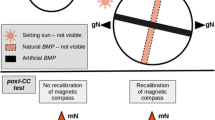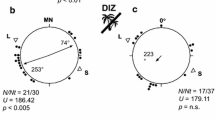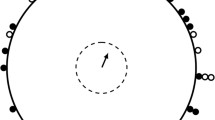Abstract.
Orientation toward breeding ponds plays an important role in the seasonal movements of amphibians. In this study, adult marbled newts were tested in a circular arena to determine sensory cues used to locate breeding ponds. Animals were collected from a temporary pond situated in northern Spain, taken to the experimental site 340 m distant, and tested for orientation under a variety of conditions (i.e., orientation under a clear night sky, orientation under an overcast night sky, and orientation under a clear night sky in the presence of an altered geomagnetic field). These investigations have demonstrated that the marbled newt is able to orient using celestial cues. Animals chose a compass course in the direction of their breeding pond only when celestial cues were available. Conversely, the ambient geomagnetic field does not seem to be relevant to orientation of marbled newts since they were unable to orient themselves using the ambient geomagnetic field in the absence of celestial cues.
Similar content being viewed by others
Author information
Authors and Affiliations
Additional information
Electronic Publication
About this article
Cite this article
Diego-Rasilla, J.F., Luengo, R.M. Celestial orientation in the marbled newt (Triturus marmoratus). J Ethol 20, 137–141 (2002). https://doi.org/10.1007/s10164-002-0066-7
Received:
Accepted:
Issue Date:
DOI: https://doi.org/10.1007/s10164-002-0066-7




